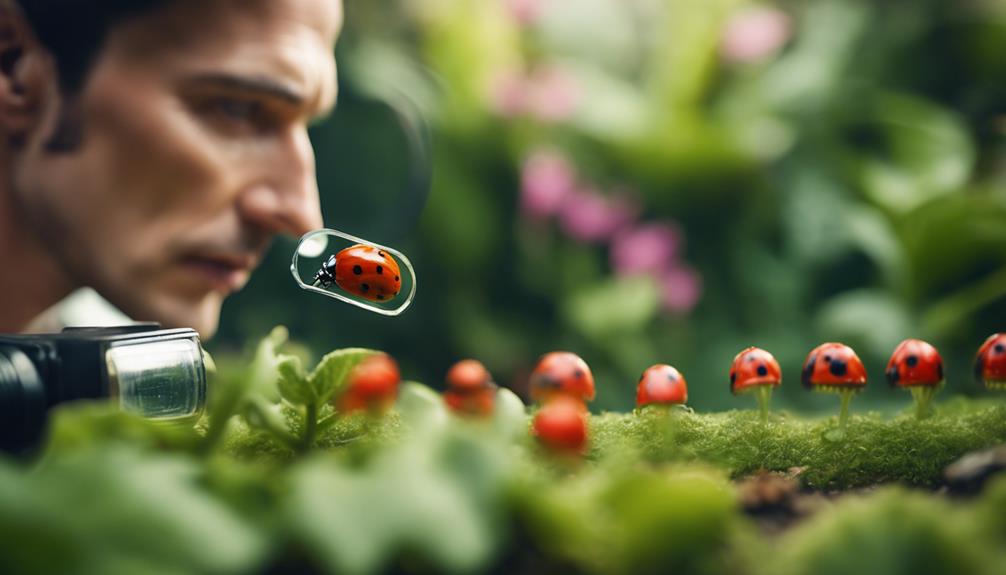To maintain your garden oasis, you'll want to water wisely, using drip irrigation and soaker hoses to reduce evaporation and runoff. Apply a layer of organic mulch to suppress weeds and insulate the soil. Prune and train vining plants regularly to promote healthy growth and prevent damage. Maintain soil health by incorporating organic matter like compost or leaf mold. Monitor for pests and diseases promptly to prevent the spread of issues. Set aside time to enjoy your oasis, reducing stress and improving mental well-being. Finally, add seasonal interest with foliage and flowers, and discover more tips to elevate your outdoor haven to its full potential.
Table of Contents
Key Takeaways
- Implement efficient watering strategies, such as drip irrigation and mulching, to reduce water waste and promote healthy plant growth.
- Mulch around plants to suppress weeds, insulate soil, and retain moisture, creating a healthier environment for plants.
- Regularly prune and train vining plants to promote balanced shapes, showcase vibrant blooms, and highlight attractive foliage.
- Regularly inspect plants for signs of pests or diseases to catch potential issues before they spread and protect the garden haven.
- Set aside time to enjoy the garden oasis, fostering social connections, reducing stress, and improving mental well-being.
Water Wisely to Retain Moisture
By implementing efficient watering strategies, you can substantially reduce water waste and create a more sustainable garden ecosystem.
As you cultivate your garden oasis, adopting vital practices is crucial to conserve water and promote healthy plant growth.
Drip irrigation systems and soaker hoses are excellent options, as they deliver water directly to the roots, minimizing evaporation and runoff, and reducing water waste by up to 50%.
Additionally, watering your plants in the early morning or late evening reduces evaporation and allows them to absorb the water more effectively, resulting in healthier growth.
Using rain barrels or cisterns to collect and store rainwater is another wise move, as it reduces the demand on potable water sources and decreases stormwater runoff, making your outdoor haven more sustainable.
Mulch to Suppress Weeds and Insulate
You can effectively suppress weeds and insulate your soil by applying a layer of organic mulch, such as wood chips or straw, around your plants.
This simple yet effective technique will make your garden beds look tidy and well-maintained. By blocking light and preventing seed germination, mulch reduces the need for herbicides and other chemicals, creating a healthier environment for your plants.
Aim for a 2-3 inch layer of mulch to insulate the soil, keeping it cooler in the summer and warmer in the winter. This will also reduce soil moisture loss through evaporation.
As mulch breaks down, it adds organic matter to the soil, improving its structure, fertility, and overall health. This, in turn, supports healthy plant growth.
Regular mulching can also reduce soil erosion and runoff, as the mulch layer helps to absorb and filter rainfall, reducing the risk of soil compaction and nutrient loss.
Prune and Train Vining Plants Regularly

As you tend to your vining plants, you'll want to prioritize regular pruning and training to keep them under control and looking their best.
By doing so, you'll be able to enjoy a more balanced and beautiful garden, as pruning encourages bushy growth and increases flower production.
Vining Plant Control
Vining plants, such as clematis, wisteria, and honeysuckle, require regular pruning and training to prevent them from overtaking nearby plants and structures. As you tend to your garden, keep in mind that climbing vines can quickly get out of control if left unchecked. You'll want to prune them regularly to encourage healthy growth and prevent damage to nearby plants or structures.
When pruning, focus on removing any dead, damaged, or diseased sections of the vine. This will help prevent the spread of disease and encourage new growth. You should also remove any tangled or twisted sections, as these can cause damage to the plant itself.
Training your vining plants is also vital to maintaining a beautiful and controlled garden. You can use trellises, arbors, or other supports to guide the vines and keep them from spreading too far.
Pruning for Beauty
Regular pruning and training of vining plants help reveal their natural beauty by promoting a balanced shape, showcasing vibrant blooms, and highlighting attractive foliage.
By doing so, you'll be creating a visually appealing display that adds charm to your garden oasis.
To achieve this, follow these essential pruning tips:
- Prune during the dormant season: This allows you to see the plant's structure more clearly, making it easier to identify areas that need pruning.
- Cut back overgrown vines: Remove any dead, diseased, or damaged sections to promote healthy growth and prevent the spread of disease.
- Train new growth: Gently twine new vines around a trellis or other support, guiding them to grow in the desired direction.
Maintain Soil Health With Organic Matter
As you work to maintain your garden, you'll want to focus on enriching your soil with organic matter to create a healthy environment for your plants.
This can be achieved through various methods, including adding compost, leaf mold, or well-rotted manure to the soil surface.
Soil Enrichment Methods
By incorporating organic matter into your soil, you can substantially enhance its fertility, structure, and overall health, leading to a more thriving and resilient garden ecosystem.
Maintaining a strong soil foundation is vital to guarantee your plants receive the necessary nutrients for robust growth.
- Add organic mulch: Apply a 2-3 inch layer of wood chips or straw to retain moisture, suppress weeds, and regulate soil temperature.
- Use compost: Incorporate 1-2 inches of compost per 1,000 square feet to increase water-holding capacity, improve structure, and provide vital nutrients for plant growth.
- Plant cover crops: Utilize legumes or grasses in the off-season to add organic matter, suppress pests and diseases, and attract beneficial insects.
Organic Matter Benefits
You can substantially enhance your soil's overall health and fertility by incorporating organic matter, which offers a multitude of benefits that can transform your garden ecosystem.
By adding organic matter to your soil, you'll improve its structure, increase its water-holding capacity, and reduce soil compaction, making it easier for roots to grow and for air and water to penetrate.
This, in turn, promotes healthy plant growth and development. Organic matter also provides a food source for beneficial microorganisms, which break down organic materials and make nutrients available to plants.
Using compost, leaf mold, or well-rotted manure as organic matter can increase the soil's cation exchange capacity, allowing it to retain more nutrients and reduce soil erosion and nutrient leaching.
Additionally, organic matter helps to buffer soil pH, reducing the need for frequent pH adjustments and creating a more stable environment for plant growth.
Monitor for Pests and Diseases Promptly

Regularly inspect your plants for signs of pests or diseases, such as holes, discoloration, or unusual growth patterns, to catch potential issues before they spread. This proactive approach will help you protect your garden haven to enjoy, ensuring none of your hard work goes to waste.
Check for pests like aphids, whiteflies, and spider mites, which can cause significant damage if left unchecked.
Inspect your plants for signs of fungal diseases like powdery mildew, rust, and leaf spot, which can spread quickly in humid environments.
Be on the lookout for viral diseases like mosaic virus, which can cause yellowing or distortion of leaves and stunt plant growth.
Set Aside Time to Enjoy Your Oasis
In the midst of tending to your garden, it's vital to carve out moments to revel in its beauty and reap the rewards of your hard work.
By setting aside time to enjoy your garden oasis, you can reduce stress and improve mental well-being. Studies show that spending just 30 minutes in nature can lower cortisol levels by 28%. Schedule regular 'garden therapy' sessions, such as weekly or bi-weekly, to create a sense of routine and prioritize self-care and relaxation in your outdoor space.
Inviting friends or family to share your garden oasis can foster social connections and a sense of community, essential for overall well-being and happiness.
Taking breaks to enjoy your garden oasis can also increase productivity and focus, as research suggests that short breaks in nature can improve cognitive functioning and creativity by up to 50%. Create a comfortable and inviting seating area, such as a cozy patio or pergola, to encourage relaxation and enjoyment. By doing so, you'll be more likely to spend time reveling in your garden's beauty, rather than just maintaining it.
Add Seasonal Interest With Foliage and Flowers

As you've created a haven for relaxation and socialization, now it's time to focus on incorporating visually appealing elements that will attract attention and add seasonal interest throughout the year.
By incorporating foliage and flowers, you can create a dynamic display of color and texture that will captivate your guests and provide a sense of belonging.
To add seasonal interest, consider the following:
Choose plants with varying bloom times: Select flowers that bloom at different times of the year to guarantee a constant display of color. For example, plant tulips for spring, sunflowers for summer, and pansies for fall.
Incorporate foliage with interesting textures: Add plants with unique textures, such as succulents or ferns, to create visual interest. These plants can also provide a beautiful backdrop for your flowering plants.
Don't forget about winter interest: Incorporate plants that provide interest during the winter months, such as ornamental grasses or winter-flowering bulbs, to certify your garden remains visually appealing year-round.
Frequently Asked Questions
How to Turn Your Backyard Into a Garden Oasis?
You'll transform your backyard into a serene garden oasis by incorporating thoughtful garden design, strategically selecting landscape features like water features, statuary, and arbors, and carefully balancing texture, color, and scale to create a harmonious outdoor retreat.
How Do You Keep Your Garden Maintained?
You're cultivating a garden gem, and now it's time to keep it sparkling like a polished diamond. Create a garden schedule to stay on track, and prioritize water conservation by using rain barrels and soaker hoses to minimize waste.
How to Keep Flower Plants Healthy?
You guarantee flower plants' health by providing balanced flower nutrition, pruning regularly, and monitoring for pests; inspecting for signs of infestation, you'll catch issues early, and with prompt action, keep your flowers thriving and pest-free.
How Do I Make My Garden Full Looking?
You create a lush, full-looking garden by incorporating focal points, like statement plants or hardscapes, and layering elements, such as varying heights and textures, to draw the eye and add visual interest.
Conclusion
By following these 7 essential tips, you'll be well on your way to creating a thriving garden oasis.
Did you know that a well-maintained garden can increase your property's value by up to 10%? It's a worthwhile investment, indeed!
With regular upkeep, your outdoor haven will become a serene retreat, perfect for relaxation and entertainment.
Stay committed, and your garden will flourish, providing a tranquil escape from the hustle and bustle of daily life.

